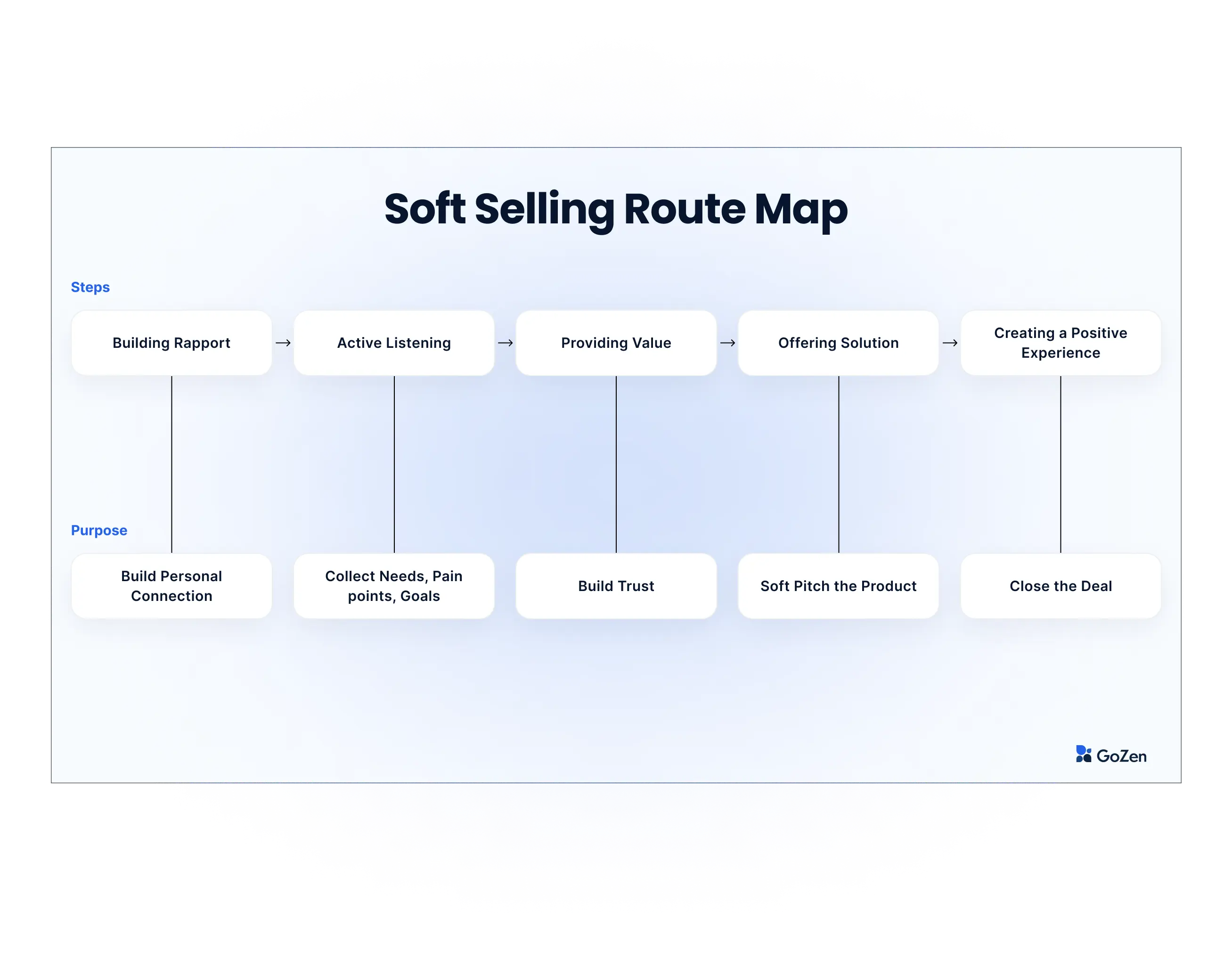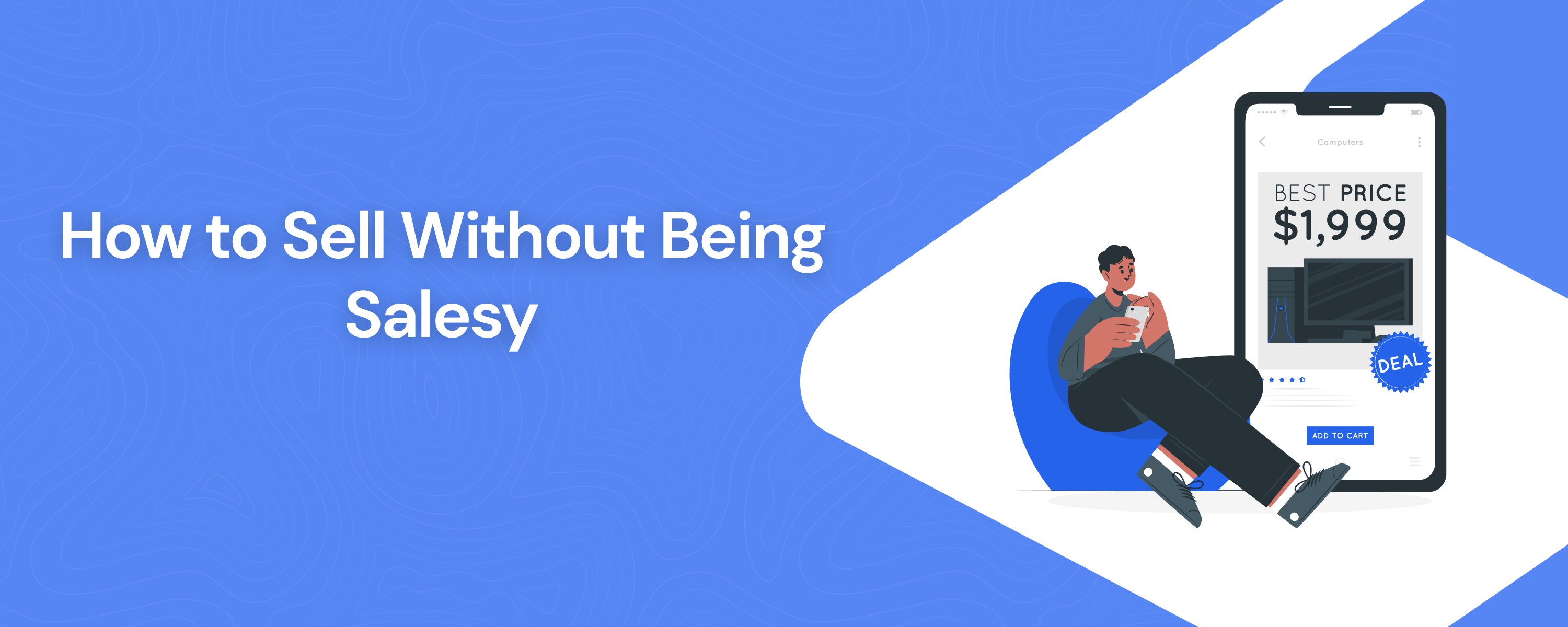Being overtly salesy in your cold calling or cold emailing is no longer as effective as it once was. In today’s digital age, people receive dozens, if not hundreds, of emails daily and have little time or patience for overly promotional messages.
The same principle applies to cold calling; nobody likes being pitched to immediately. Think about it—would you?
In this article, we’ll explore how to avoid sounding salesy in your cold outreach and instead create genuine connections that lead to lasting customer relationships.
You’ll also learn how to write a cold calling and cold emailing script from our in-house sales experts.
Let’s dive in and transform your approach from irritating to engaging.
Table of Contents
What Does Salesy Mean?
The term “salesy” describes salespeople who use aggressive and superficial sales pitches.
Salesy pitches are product-centered rather than client-centered, making prospects uncomfortable and could lead to unresponsiveness or sometimes anger.
Consequently, salesy pitches often fail to convert prospects into paying customers and can even drive them away from the product.
Examples of Being Salesy
A salesy pitch occurs when a salesperson is unaware of the prospect’s background, needs, and stage in the sales funnel.
Though being salesy is a characteristic of hard selling, there is a fine line between being salesy and hard selling.
The main difference that distinguishes both approaches is that hard selling involves putting more effort into analyzing the prospect’s background, gathering product knowledge, and leveraging the proof of concept.
On the other hand, the salesy pitch is blunt and superficial. The salespeople who are being salesy might typically lack the prospect and product knowledge.
The salesy pitches usually come from naive salespeople.
Here’s an example of a salesy pitch:
An extreme example of being salesy:
In some cases, some salespeople use deceptive and unethical sales tactics like “bait and switch” to get a sale.
“Bait and switch” is an approach that involves advertising a product or service at a very attractive price (the “bait”) to lure customers in, only to inform them that the product is unavailable or to push them towards a more expensive alternative (the “switch”).
The “bait and switch” approach is considered as salesy for the following reasons:
This technique not only comes off as salesy but also erodes customer trust and can lead to negative reviews, complaints, and potential legal issues.
How to be Non-Salesy?
Time has changed and no more self-centric conventional sales pitches work anymore. People have already started hating sales pitches that are:
A lot of salespeople are being salesy to increase sales effectiveness. But, sales pitches with these characteristics have become counterproductive nowadays.
So what will be going to work? Let’s take a look at it.
Soft Selling
Soft selling is the key to selling if your target market is crowded.
Soft selling is a sales approach focused on building relationships and trust with potential customers rather than directly pushing for a sale.
This technique involves understanding the customer’s needs, providing valuable information, and positioning oneself as a helpful advisor. For instance, Miami injury lawyers often use soft selling to connect with potential clients. By offering guidance on legal rights and solutions to personal injury cases, they build trust and position themselves as reliable advocates rather than just service providers.
The aim is to create a positive experience that leads to a natural and comfortable sales process.
The time taken to close a sale in soft selling is generally longer compared to hard selling.

Core Components of Soft Selling

Building Rapport
Starting from the first point of contact, you need to build a personal connection with your leads and prospects; be it a cold email or cold calling.
To build such personal connections, you need to know about them and their business to create a personalized message to start with.
If you think it’s difficult and impossible to understand your leads and prospects from a list of thousands, think again.
To ease the process of creating a personalized message for your thousands of prospects in a few seconds to minutes, you can use HyperReach.Ai.
The HyperReach.Ai is an AI-powered tool that creates hyper-personalized cold email content based on your prospect’s social signals, education, and work experience.
The tool also has a feature called “list building” that allows you to build your prospect list along with verified email addresses.
An example of a personalized cold message created by HyperReach.Ai:
Doesn’t this message create a solid initial connection? It surely will compared to non-personalized cold messages that are salesy.
Active Listening
Once you have established a personal connection with your leads and prospects, you need to actively listen to their problems and needs.
Engage in a conversation to uncover the customer’s pain points, needs, and goals.
Provide Value
Now that you know what their needs, pain points, and goals are, you can start providing value in your subsequent emails or calls.
Share useful information, insights, and resources that can help the customer, even if it doesn’t directly lead to a sale.
Showing your knowledge and expertise in the field can help build credibility and trust in you and the company you are representing.
Offer Solution
By now, you have earned your trust by selflessly helping your prospects.
Now, you can slowly open up about your product and how it can further help your prospects achieve their goal.
At the same time, be honest about what your product or service can and cannot do. Avoid making exaggerated claims.
You can also use real-life examples of how others have benefited from your product or service at this stage.
Gentle Follow-Up
Once you have introduced your product, give the customer enough time to make their decision. Avoid pressuring them into making a quick purchase.
Just maintain contact with the customer via optimal follow-up sequences, offering further assistance and support without being pushy.
Example of Soft Selling Script
Initial Contact: “Hi there, I noticed your company has been making great strides in the tech industry. How have you been managing your customer support with the increased demand?”
Listening and Understanding: “That’s interesting. It sounds like you’re facing some significant challenges with scaling your support team. What specific issues have been the most difficult to manage?”
Providing Value: “I’ve worked with several companies in similar situations. One strategy that has helped is implementing an AI-driven support system. I can send you a case study of a company that saw a 40% reduction in response time. Would that be helpful?”
Offering a Solution: “If you’re interested, we can set up a demo of our AI-driven support system. It’s designed to integrate seamlessly with your current processes and could really help alleviate some of those pain points you mentioned.”
By focusing on understanding the customer’s needs and providing tailored advice, you can build a relationship that naturally leads to a sale without the pressure of hard selling tactics.
Benefits of Soft Selling
The Dale Carnegie Method and Soft Selling
Dale Carnegie’s book “How to Win Friends and Influence People” is an essential read for every salesperson.
It reveals the science of dealing with people through real-time examples, embodying the essence of soft selling.
Here’s how some key principles from the book align with a soft-selling approach:
Become genuinely interested in other people (Chapter 2, Principle 1): Show genuine curiosity and care about your customer’s needs and interests, building a strong foundation for trust and rapport.
Be a good listener (Chapter 4, Principle 4): Focus on listening to your customers attentively, understanding their pain points, and letting them feel heard and valued.
Talk in terms of the other person’s interests (Chapter 5, Principle 5): Tailor your conversations to align with what matters most to your customers, making your solutions more relevant and appealing.
Make the other person feel important (Chapter 6, Principle 6): Acknowledge and appreciate your customer’s opinions and contributions, enhancing their sense of importance and trust in your relationship.
Ask questions instead of giving direct orders (Chapter 4, Principle 4): Encourage a two-way dialogue by asking insightful questions rather than dictating what the customer should do, fostering collaboration and understanding.
Arouse in the other person an eager want (Chapter 3, Principle 3): Create a desire for your product or service by highlighting how it meets the customer’s needs and aspirations, motivating them to take action.
By applying these principles, you can master the art of soft selling, focusing on relationship-building and understanding your customers to achieve successful, long-lasting sales outcomes.
Sales Pitch Insights from Our In-house Sales Experts
Here are a few important sales pitch insights from our in-house salesperson Goutham Prakasham.
When asked about what a good sales pitch looks like, Goutham Prakasham replied with: Pitching the right product to the right customer is the key.

To do so:
He also emphasized that follow-ups are essential in sales. But, it should be gentle in sequences and tone.
According to his experience, hard selling is not working in b2b SaaS nowadays.
Conclusion
Soft selling has proven to be an effective and transformative approach in today’s competitive sales environment.
By focusing on building relationships, understanding customer needs, and offering genuine value, our in-house sales team has successfully leveraged soft selling techniques to close deals more efficiently and sustainably.
The timeless principles outlined by Dale Carnegie in “How to Win Friends and Influence People” continue to resonate, underscoring the importance of empathy, trust, and connection in sales.
As we move forward, embracing these strategies will not only drive our success but also foster lasting partnerships with our clients.
However, the conventional hard-selling approach might work in more unique and less competitive niche markets.
But, it will not help you get decent sales in more crowded markets.
You can use the combination of hard selling and soft selling when you want to sell low-cost products.



